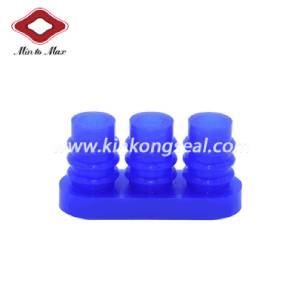Feb. 27, 2020
Summary:
There are two main methods for coloring custom rubber components: surface coloring and color mixing. On the surface table, a colorant is sprayed on the surface of a rubber product to color the rubber product. This method has a certain effect on static products, and on dynamic products, the colorant is easy to peel off and fade. Mixing coloring is the main method of rubber coloring at present, divided into two methods: solution method and mixing method. The mixing method includes dry powder coloring, color paste coloring, pellet coloring, and masterbatch coloring.
Solution coloring
The method is to dissolve the rubber into a certain concentration solution with its good solvent, then add the colorant and the rubber compounding agent except sulfur to the solution, stir and mix well, dry and remove the solvent at a certain temperature, and finally on the rubber mixer Add sulfur. This coloring method has complicated operations, uneven dispersion of colorants and complexing agents, color difference, difficult recovery of solvents, and pollution of the environment, and has been rarely used at present.
Kneading method
This method is currently the most commonly used method for silicone rubber wire seal coloring. It is to add the colorant directly or mix it with the carrier first and then add it to the rubber compound. Mix it evenly with a rubber mixer to color the rubber. . The specific method is as follows.
Dry powder coloring This method is to add the powdery colorant into the rubber together with the small material, and mix it on an open mill. The advantages of this method are simple operation and low cost, but the dust is large during mixing, pollutes the environment, and it is not easy to disperse uniformly, and there is chromatic aberration. If the particles are too hard and coarse, it will also cause quality problems such as color point, streaks or mutual pollution of chromatography It has been used less frequently. For ease of use, a powdered colorant can be made into a pre-dispersed colorant together with stearic acid, sulfate, and the like, which are already on the market.

Custom Rubber Components
Color paste coloring This method is to first mix the colorant with a liquid compounding agent (such as a plasticizer), grind it with a three-roller machine to make a paste or slurry, and then add it to the rubber in a certain proportion and knead. This method can avoid dust flying, and it is also beneficial for the colorant to be dispersed in the rubber, and the color is uniform. However, the content of the colorant in the color paste is low, the coloring is not high, the transportation volume is large, the loss is large, and the user is inconvenient to use.
There are two main methods for preparing pellets and colorants. The first method is the same as other powdery compounding agent granulation methods. The powdery colorant is first wetted with a surfactant, and then granulated by wax melting or resin extrusion. The second method is to use a colorant. After the surfactant is soaked, the colorant particles are refined by mechanical force to make a dispersion with a certain concentration, and then mixed with the latex to co-settle. After drying, it is rolled into pellets. The surfactants are mostly anionic and non-ionic, such as fatty acid salts, sulfonates, etc. Natural rubber latex is usually used. This granular colorant is convenient to use, has good dispersibility, no dust flying, no pollution to the environment, bright color, uniform hair color, and no color difference, and is a promising coloring method. However, the granular colorant has a complicated preparation process and high cost, which limits its wide application.
Masterbatch coloring This method is to first mix the colorant, some plasticizers and other rubber compounding agents with raw rubber through an open mill to make a colorant masterbatch with a concentration of about 50%, and then blend it in proportion Stained in rubber. This method is more effective for coloring particles with fine particles and difficult to disperse, with uniform color development and no color difference. When mixing, pay attention to the concentration of the colorant in the masterbatch and deduct the amount of other compounding agents in the masterbatch.
Tel: +86 13705057546
E-mail: info@kinkong.com
Add: #27 Hengjing Xiyi Road, Liushi Town, Yueqing City, Zhejiang Province, 325604, China.
Copyright © Min To Max All Rights Reserved |